Mount Kilimanjaro view from a campsite.
We plan and organize your trip to the roof of Africa, so you can fully experience the Kilimanjaro and see it's wonders of mountain wildlife and unique landscape.
The roof of Africa, tallest free standing mountain in the world, and a true wonder to be conquered at least once in your life.
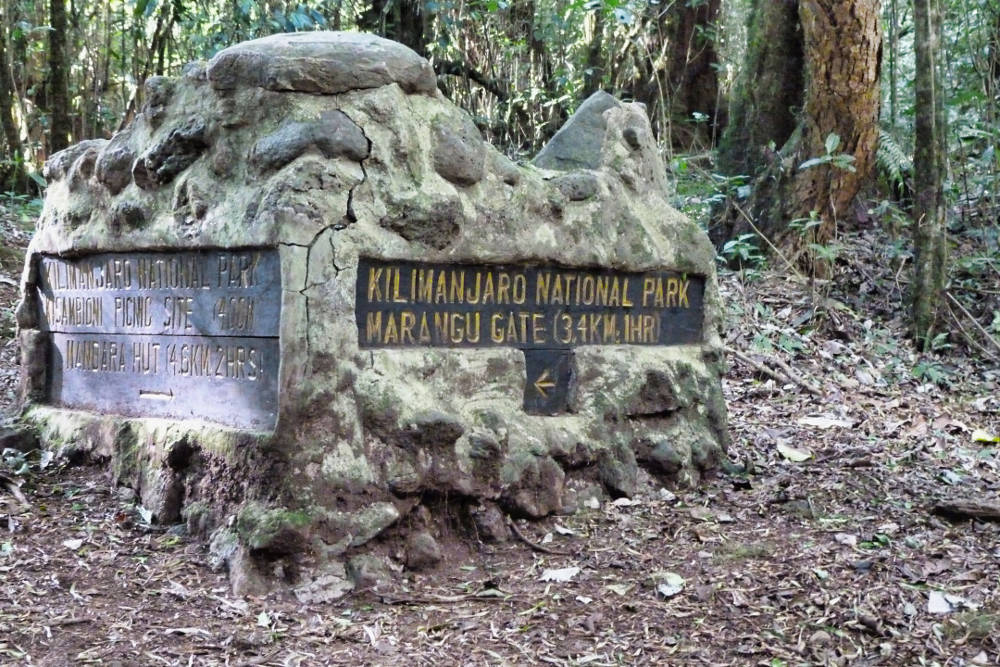
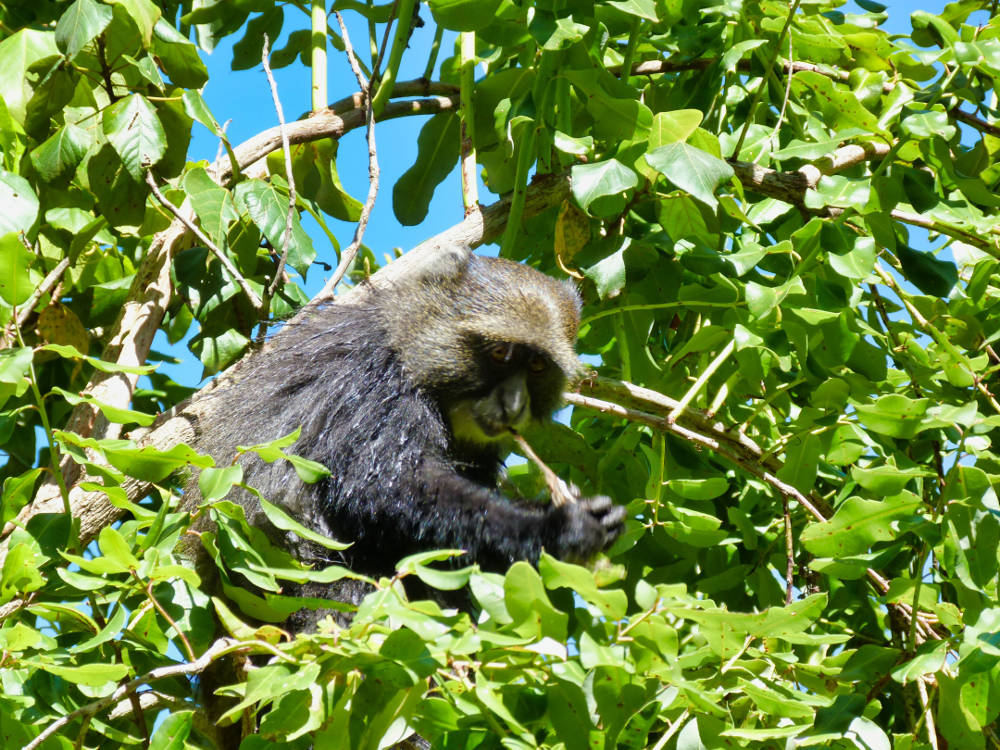
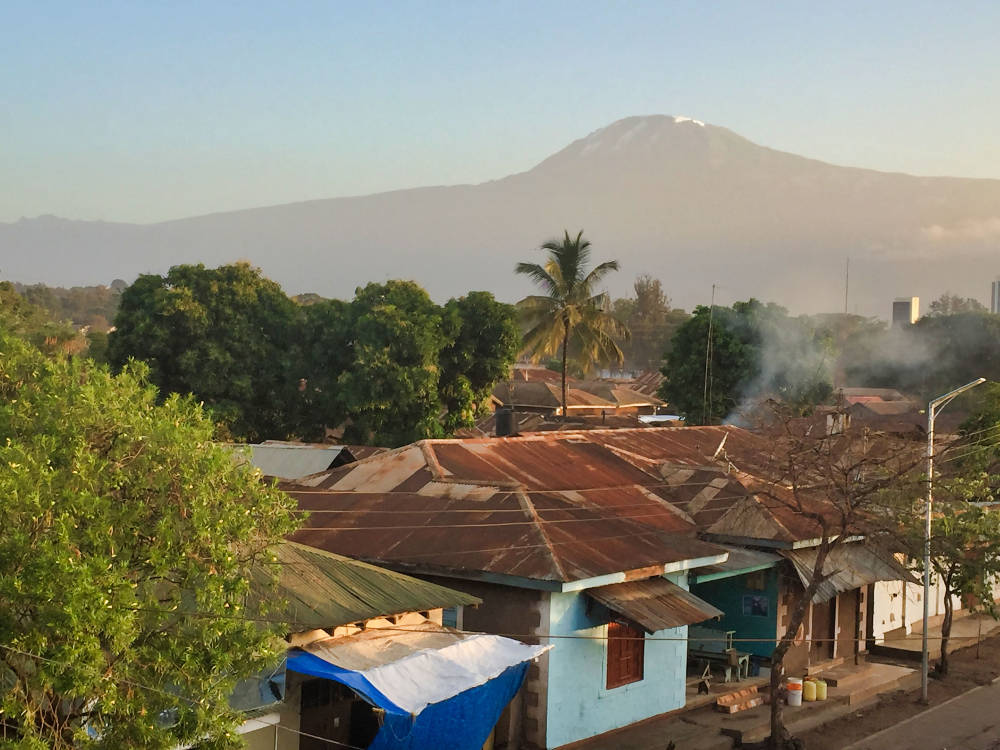
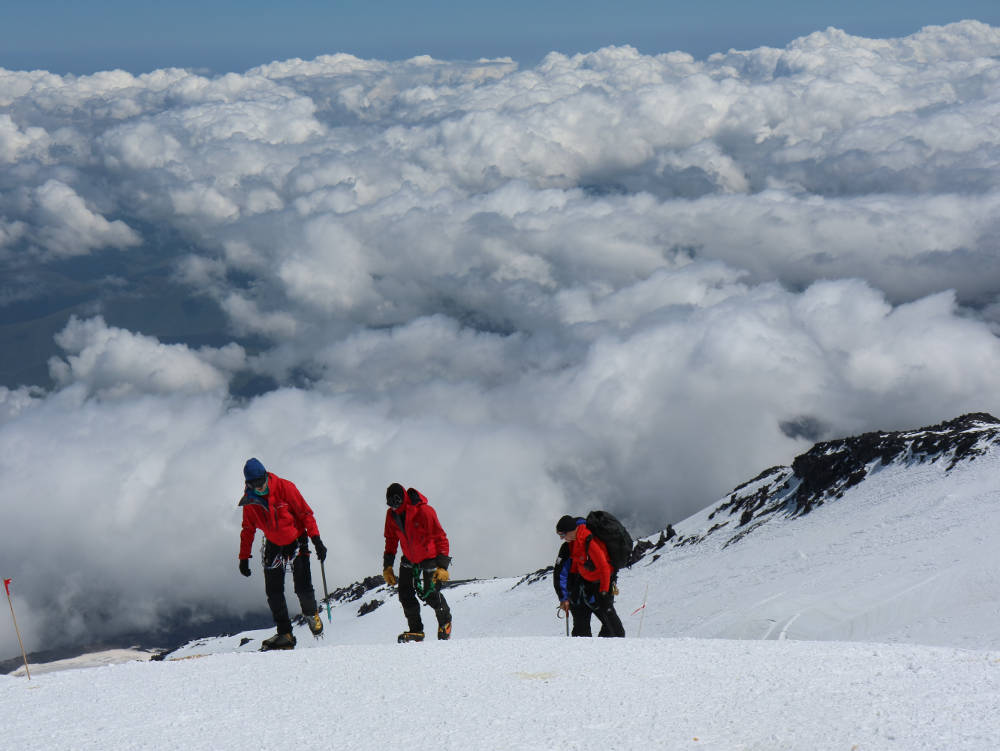
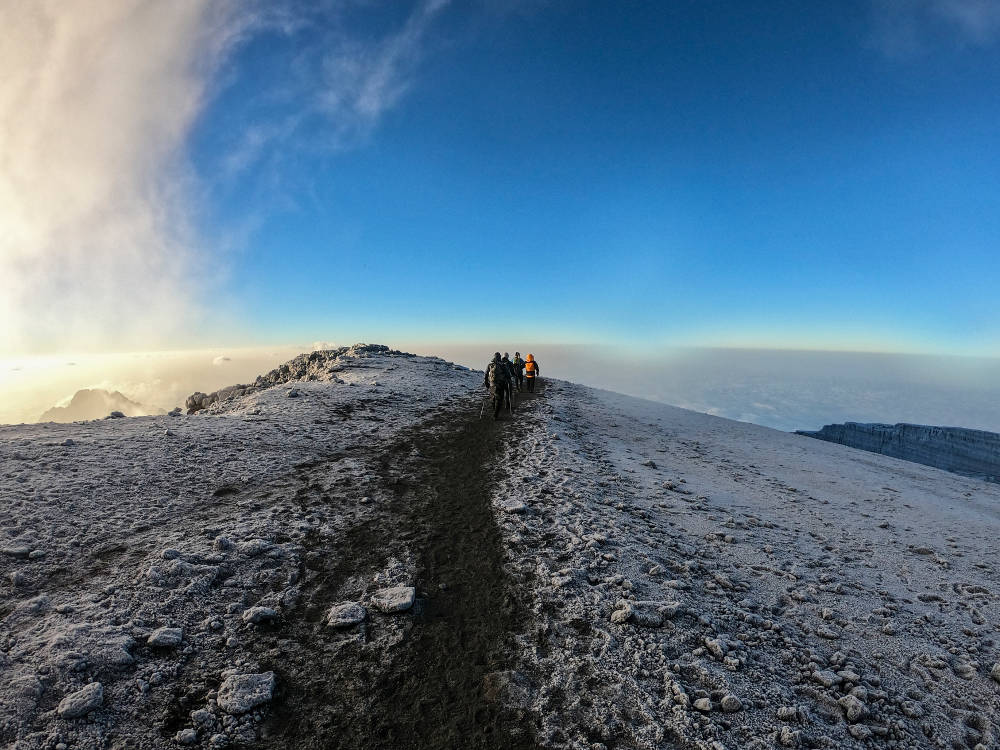

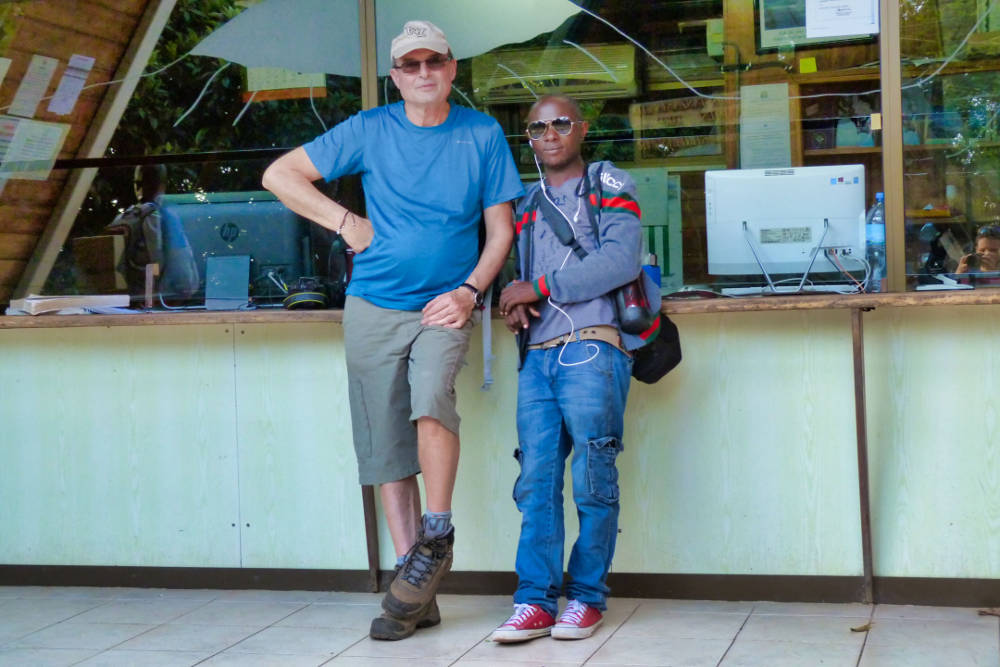
Trip Highlights
Both trips itineraries includes
two nights in Moshi town, one night before heading to
Kilimanjaro mountain for trekking and one night after
the trekking.
After arrival, you will be picked up from
the bus station, Kilimanjaro Airport or Arusha Airport
and brought to your hotel for lunch/dinner and overnight.
The
following morning you will be picked up from the hotel after
your breakfast and driven to Marangu gate to start your
trekking. After making it to the summit and got back down,
you will be awarded a certificate at the gate. The last day
you will get back at your hotel to rest and celebrate your
accomplishment.
Your chief guide will be there to explain
everything for you and we will look after you.
Trip at a Glance
See detailed itinerary.
Detailed Description
The Famous Mount Kilimanjaro is
the highest mountain in Africa and is considered the tallest
freestanding mountain in the world, rising 15,100 feet
(4600 metres) from its base to summit.
Location:
Kilimanjaro Region, Tanzania, East Africa, African.
The
Kilimanjaro name is coming from mixing Swahili and Chagga
tribes slang, which means “that mountain”. The Kilimanjaro
is composed by three distinct volcanic cones: Shira 13,000
feet (3,962 metres), Mawenzi 16,896 feet (5,149 metres)
and Kibo at 19,340 feet ( 5, 895 metres) from which the
Uhuru peak is the highest summit.
Kilimanjaro is
actually a giant strato-volcano that began forming a million
years ago when lava spilled from the rift valley zone,
the mountain was built by successive lava flows.Two of its
three peaks, Mawenzi and Shira are extinct while the highest
peak, Kibo is dormant and could erupt again, the last major
eruption was 360, 000 years ago, while the most recent
activities happened 200 years ago.
Kilimanjaro has 2.2
sq km of glacial ice and is losing it quickly due to global
warming, the glaciers have shrunk 82 percent since 1912 and
declined 33 percent since 1989, it may be ice free within
20 years, dramatically affecting local drinking water, crop
irrigation and hydroelectric power.
Kilimanjaro lies within
the 756 square kilometers of a UNESCO World Heritage Site
and it is one of the few places on earth that encompasses
every ecological life zone including tropical jungle,
savannah, desert to mountain forests, subalpine plants and
the alpine zone above timberline.
According to the
rules and regulations within the Kilimanjaro National Park
Authority (KINAPA), hikers are not allowed to enter the park
without a guide(s) and accompanying porters. Depending on
the route, one to four porters are required for permission
to climb. If a hiker wishes to trek without the support
of porters, which means they plan to carry their luggage
by themselves, then they should notify us prior making the
booking reservation.
Places Visited
Moshi Town, Marangu and the Kilimanjaro Mountain.
Departures Dates
Dates are flexible and customizable for private departures.
Itinerary
Option 1:
5 to 6 day
programme through Marangu route
This trail is
popularly called the tourist route or “Coca-Cola” route,
this could partly be as a result of the fact that the
Marangu is the expensive route, but more so, perhaps the
fact that it is possible to do the marangu route in 5 days,
thereby getting to the summit one day earlier than on the
Machame route. This route however offers the visitors the
option of spending on extra acclimatization day at Horombo
hut, Hut accommodation on the Marangu route forms one of
the mains differences, compared to the other routes. All
your equipment and supplies are pottered and a chef prepares
all your meals.
IMPORTANT: For those who
have picked the five days, they have to follow this program
up to day 4 then to Kibo hut instead of resting at horombo
hut.
Day 00 – Moshi
Pick up
from the bus station, Kilimanjaro International Airport or
Arusha Airport to the hotel.
Day
01 – Marangu Gate 1860 m – Mandara Hut 2720 m
Habitat: Montana Forest
Hiking
time: 4 – 5 hrs.
Pickup in your hotel after
finishing breakfast and drive from Moshi to Kilimanjaro
National Park gate, about 1hr drive, after registration
at the main gate, porters, cook, chef and guides prepare
and pack the supplies for all 5 to 6 days and your
equipment and measure on the scale of kilimanjaro National
Park ready to be carried by porters. Make sure that that you
have all your daypack items (containing at least valuable
things (drinking water and your lunch pack and extra
clothing) with you as the porters ascend a lot quicker than
the hikers. You now leave the gate and ascend through to the
Montana forest. The forest suffused with mist and dripping
with beards of moss is where by most Kilimanjaro animals are
found. After 2 hours or 1 hour and a half you have to stop
in the place called kisamboini for a lunch. Kisamboini is a
chagga tribe word which means place of washing. After lunch
you continue to step up to the end of Montana forest start
heather and Moorland up to 2720m in Mandara hut overnight.
Day 2 – Mandara Hut 2720 m –
Horombo Hut 3720 m.
Habitat: Heather and
Moorland
Hiking Time: 5 – 6 hours.
From
Mandara hut the trail passes through as short stretch of
forest, then skirts the base of the Maundi crater and then
emerges into the transition from rain forest to moorland. It
is well worth a short detour to scramble up the rim of the
Maundi Crater for your first really impressive views of the
Kibo Crater. On clear day. Once its clear the visitors have
a chance to see most spectacular plants the endemic giant
lobelia which grows up to 3 m in height and the senecio
Kilimajari or giant groundsel which can reach the height of
5 m. After 4 hours you will be able to continue to moorland
area, and finish the steep of WONA MOUNTAIN which has simple
desks and tables for lunch. After finishing a lunch break
you start to climb for a 2 hours up to horombo hut, where
you will have hot washing water, rest an evening meal and
overnight.
Day 3 – Horombo Hut
3720 m (For acclimatization)
Horombo hut is
a meeting point to both ascending and descending hikers.
This extra day and night at horombo is for additional
acclimatization for those who have taken 6 days and one
day acclimatization they have a chance to go near mawenzi
ridge passing zebra rocks on the way ( About 4 hours up and
2 hours down) which is strongly recommended. This hike will
further assist with the process of acclimatization. Remember
to drink enough water and move slowly, All meals for the day
are provided at the hut. Go to the bed early and get a last
goodnights rest.
Day 4 – Horombo
Hut 3720 m – Kibo Hut 4700 m
Habitat:
Desert Place
Hike Time: 6 hours – 7 hours.
Early in the morning after finishing the breakfast
start to ascend the end of the moorland up to Maua River,
the Maua River is a place for filling all the water for
use at kibo hut because this is the last water point as
there is no other source of water after passing through
which is located at a picnic site with simple desks and
tables. The path begins to loop north between the Kibo
summit on your left and middle red hills on your right
provided the venue for lunch. After getting a lunch continue
slowly for 3 hours to desert place up to Kibo hut for
preparation of dinner, rest and time to the summit.
Day 5 – Kibo 4700 – Gilmans – Uhuru
Peak – Horombo Hut
Habitat: Desert Place /
Summit Hike
Time: 10 - 15 hours.
At
around 23:00 pm get some tea with biscuit and get ready
to start to summit around 23:30 pm through stone and sand
scree up to Williams point and get rest for approximately
coming 3 hours to Hans Meyer Caves 4812 m. After Hans
Meyer Caves the trail is going zigzag or switch packs up
to the phase of climbing rocks to the sight post welcoming
to Gilmans point for a 2 and half hours from Hans Meyer.
Roughly time to be in Gilmans is around 5:30 am in order
to have a chance of seeing the sunrise at Uhuru around
6:30 am. This way from Gilmans to Uhuru Peak is through
the junction called Stella Point which is quite easy. After
getting at Uhuru peak enjoy a stunning of the walls then
descend back through to stella Point, Gilmans Point up
to Kibo Hut for rest, eating lunch and packing for going
down to overnight at Horombo Hut. From Kibo to Horombo
is about 3 hours down.
Day 6
– Horombo Hut – Marangu Gate
Habitat:
Moorland and Montana Forest
Hiking Time: 5 –
6 hours.
After Breakfast descend down to Marangu
gate where you have a chance to stop for lunch in Mandara
hut. For those who reached Gilmans Point, Stella point
and Uhuru Peak are awarded certificate at the main gate.
Make sure you tip the guide, cook and porters according to
the information that you were given by Mount Kilimanjaro
Trails. Enter the car go down for the hotel and shower,
celebrate certificate and overnight.
Option 2 :
6/7-Day programme through Lemosho route
The Lemosho Route is a relatively new variation
of the traditional Shira Plateau route. This is the third
most popular route on the mountain. You can book for
6-7 days, even up to 10 days. This route starts with a
rough drive from West Kilimanjaro to the Londorosi Gate;
Remote and spectacular with dramatic gorges and views of
West Kilimanjaro, climbers join the Machame Route for the
summit.
DAY 1 - Londorosi Gate - Mti Mkubwa
2500 m
Habitat: Montana Forest
Hiking Time:
3 hrs
You will be picked up at your hotel after getting
breakfast, and drive from Moshi to Bomangombe. Fom here
we will turn to the Londorosi Gate for registration and
measure all luggage to the scaling standard of the national
park and obtain a permit. We than begin our 3hr journey
over to the starting point and up to Mti Mkubwa Camp at
approx 2650 m. The terrain is that of Montana forest,
where we can view some colobus monkeys hanging in bush for
3hrs. We overnight at Mti Mkubwa.
DAY 2 -
Mti Mkubwa 2500 m - Shira 1 3480 m
Habitat:
Montana Forest/Heather & Moorland
Hiking Time 4-5
hrs
After breakfast, we continue our ascension across
the dense rainforest, where climbing is gradual and becomes
steeper before reaching a wide moorland zone where you will
get proper news of the Shira Plateau and its accompanying
ridge and peaks. It is here that you finally get views of
Kibo. From here, we go down the moorland then up to Shira
1 whereby you'll find your chefs, porters and camping crew
already preparing for lunch anddinner for your overnight
stay.
DAY 3 - Shira 1 3480 m - Shira Hut
3840 m
Habitat: Moorland
Hiking Time: 5-6
hrs
Breakfast is served first thing in the morning.
This is a good day for acclimatization for those who have
more climbing time on their schedule (8 days up to 10days
of climbing). Next we proceed gently east across the
Shira Plateau and Shira Cathedral towards Shira Hut on the
moorland. It is an excellent place in this route to visit
this first eruption in themountain. Afterwards we go back up
to Shira Hut for the overnight camp.
DAY 4 -
Shira Hut 3840 m - Barranco Camp 3950 m
Habitat:
Alpine Desert
Hiking Time: 7-8 hrs
After getting
a breakfast, we continue on the trail to join up to
the junction point where you can meet visitors from the
Machame Route. We continue up the steep path to the lava
tower to an altitude of 4600 m. At this point of the day
due to altitude, some climbers start to feel symptoms of
breathlessness, irritability and headaches. After lunch we
descend again by almost 680 m to the Barranco Camping area.
This is the opportunityto take some beautiful photographs
of the Western Breach and Breach Wall. The camp is situated
in the Great Barranco Wall valley, which should provide
you with a most memorable sunset while you wait for the
preparation of your dinner. The remainder of the day is
meant for acclimatization.
DAY 5 - Barranco
Camp 3950 m - Barafu Camp 4600 m
Habitat:
Alpine Desert
Distance: 12 km
Hiking Time: 7-8
hrs
After spending a night at the Great Barranco Wall,
we make our way up to just below theHeim Glacier. From here
you will appreciate just how beautiful Kilimanjaro really
is via the views. The route then heads down through the
Karanga Valley which the last water stop on the route over
intervening ridges and valleys before it join up with the
Mweka Route, the preferred route down the summit. Barafu is
the Swahili word means \"ice\" and you ascend up to ridge
to 4600 m high. It is at Barafu Camp that you will spend
the nightexposed to the over present gates in tents pitched
on a narrow and stony ridge.
PLEASE NOTE: For some
hikers who want to reach the summit for 7 days they prefer
an overnight at Karanga Camping. But most guides or tour
organizers misname this by saying overnight at Karanga
Valley while in reality you overnight at the Top of Karanga
Valley.
DAY 6 - Barafu Camp 4600 m - Uhuru
Peak 5895 m - Mweka Camp 3100 m
Habitat: Scree
& Ice-capped Summit
Hiking Time: 9-10 hrs to reach
Uhuru Peak & 6-7 hrs to descend to Mweka
We leave
around midnight, between 2300-2330hrs to ascend through
heavy scree to Stella Point (5568 m) on the crater rim.
Here we stop for a short rest and, weather permitting,
youll experience the most magnificent sunrise you are very
likely to see. Thenyou start your summit attempt, ascending
for about 2hrs to Uhuru Peak (5895 m), the highest point in
Africa. Enjoy stunning views of the ice wall, then descend
back down to rest before heading down to Mweka Camp (3100
m) to overnight in the upper rain forest.
DAY
7 - Mweka Camp 3100 m - Mweka Gates
Habitat:
Forest
Distance: 15 km
Hiking Time: 3 hrs
After
an early and well deserved breakfast is a short 3hrs
scenic hike bake to the Mweka Park gates. Those who reached
Stella Point and Uhuru Peak are awarded with Certificate
of Completion. Then, you are transferred back to your hotel
for a long overdue hot shower with time to relax
Option 3 :
6-7 Day programme through
Machame route
Machame route begins on the
southern west side of the mountain, the trail passes through
some of themountain finest features including cloud forest
of Kili southern slopes, the dry and dusty Shira Plateau
and the delightful senecio clad Barranco campsite. We
have opportunity to summit at this two side western breach
route and Barafu trails and descend in Mweka gate.Machame
is the most beautiful route in Kilimanjaro which was the
nicknamed whisky route but you must be physically fit
enough to walk about 75 km. This is a tent experience;
a more benefit for this route is valuable commodity on
the mountain acclimatization. The hiker(s) is rewarded
with exquisite scenic wonders, from late afternoon and
to sunsets at Shira to the mist revelation of Kibo at the
great Barranco wall.
DAY 1 - Machame Gate
1490 m - Machame Camp 3000 m
Habitat: Montana
Forest
Distance: 17 km
Hiking Time: 5-6hrs
Pick
up in your hotel after getting breakfast and drive from
Moshi to Machame gate 45minutes. After registration in the
gate, porters, cook or chef and guides prepare and pack
the supplies youre your equipment and measure to the scale
of national park (KINAPA). You start to ascend and enter
to the Montana forest where it is likely to rain and make
the trail muddy and soggy, after lunch stop in the half
way continue to the 3000 m in Machame camp area where your
camping crew team and porters arrived before you do will
have erected your tent. In the evening the chef will serve
you boiled water, dinner, before you retire to your tent
for night. Night temperature can already drop to freezing
point at this camp site.
DAY 2 - Machame Camp
3000 m - Shira Camp 3800 m
Habitant: Heather
Moorland
Distance: 9 km
Hiking Time 5-6hrs
You
wake up early at Machame camp and after getting a breakfast
you start to go to Shira Camp. This day is too short but
more steep climb north up through forest as slanted. Ahead
of you in a distance a lip of Shira plateau 3848 m is seen
in the western part. After you continue to the lunch point
in the half way you proceed to go 1.5hrs up to the Shira
camp. At the Shira camp the chef, porters and camping crew
are ready to direct you to the tent and for you to wait
for the dinner.
DAY 3 - Shira Camp via Lava
Tower 3800 m - Barranco 3950 m
Habitant: Alpine
Desert & Moorland
Hiking Time: 7-8 hrs
After
climbing/trekking through to Alpine desert ascend in the
rock, scream path to the lava tower to analtitude of 4600 m
at this point of the tough day some climbers start to feel
symptoms of breathlessness, irritability and headaches.
After lunch at the lava tower descent again by almost 680
m to the Barranco Camping area. This is the opportunity
to take some beautiful photograph of the westernBreach and
Breach wall. The camp is situated in the valley by Great
Barranco Wall, which should provide you memorable sunset
while you wait for the preparation of your dinner. This is
day for acclimatization.
DAY 4 - Barranco
Camp 3950 m - Barafu Camp 4600 m
Habitat: Alpine
Desert Distance: 12 km
Hiking Time: 7-8hrs
After
spending a night at Great Barranco wall you are now making
your way up, this is an awesome looking obstacle which in
the normally turns out easier than what you anticipated.
Topping out just below the Heim Glacier. You now appreciated
just how beautiful Kilimanjaro really is. The route then
heads down through the Karanga Valley, the last water point
on the route over intervening ridges and valleys before
it joins up with the Mweka, the preferred route down the
summit.Barafu is a Swahili word which means ice and you
ascend up to ridge to 4600 m high Barafu camp to spend the
night exposed to the over present gates in tents pitched
on narrow and stony ridge.
PLEASE NOTE: For some
hikers who want to reach the summit for 7 days they prefer
an overnight at Karanga Camping. But most guides or tour
organizers misname this by saying overnight at Karanga
Valley while in reality you overnight at the Top of Karanga
Valley.
DAY 5 - Barafu Camp 4600 m - Uhuru
Peak 5895 m - Mweka 3100 m
Habitat: Scree and
Ice-Capped Summit
Hiking Time: 9-10 hrs to Uhuru Peak /
6-7hrs to Mweka
Leaving around midnight 23.00 23.30 to
ascend through heavy scree to Stella Point (5568 m) on the
crater rim, stop for a short rest and weather permitting to
experience the most magnificent sunrise you are very likely
to see. Then start your summit attempt ascending for about
2hrs to Uhuru Peak 5895 m, the highest point in Africa.
Enjoy stunning views of ice wall, and then descend back to
rest before heading down to Mweka camp (3100 m) to overnight
in the upper rain forest.
DAY 6 - Mweka Camp
3100 m - Mweka Gates
Habitat: Forest
Distance
15 km
Hiking Time: 3hrs
After an early and well
deserved breakfast follows a short 3hrs and scenic hike
back to Mweka Park gate. It is strongly recommended to
pay tips to the porters and guide(s) as you were requested
byKiliSmile Trails.Those who reached Stella Point and Uhuru
Peak are awarded with Certificates. Then transfer back
to your hotel for a long overdue and hot shower with time
to relax.
Option 4 :
7 Days
programme through Rongai route
DAY
1 - Simba Caves/First Caves 2830 m Kikelewa Caves 3600 m
Habitat: Heather & Moorland
Hiking Time:
7-8hrs
After getting a breakfast you will leave the
Simba caves for steep climbing to the Second Caves where you
will have lunch in shadow of Kibo. Through the heather and
moorlands we will continue drifting a path up to Kikelewa
Caves for an overnight stay. This is long and tough day for
trekking.
DAY 2 - Kikelewa Caves 3600 m -
Mawenzi Turn 4315 m
Habitat: Desert
Hiking
Time 5hrs
After breakfast, we head up towards the Mawenzi
Turn Hut where we will camp in shadow of Mawenzi. Here
you can enjoy the sunset behind Kibo.
DAY
3 - Acclimatization Day
This is our day for
acclimatization.
Wake up time is around 0900 for
breakfast, then a short walk up to Mawenzi. We climb for
2hrs then descend back down for 1hr back to the same camp
for the night.
DAY 4 - Mawenzi Turn 4315
m Kibo Hut 4720 m
Habitat: Desert
Hiking
Time: 5-6hrs
After breakfast, we leave Mawenzi Camp and
head up to Kibo Hut, walking through an alpine desert. You
will have an early dinner so that you can get some rest for
the summit climb.
DAY 5-6 - Kibo Hut 4720 m
Gilmans Point Uhuru Peak Horombo Hut
Habitat:
Desert / Summit
Hiking Time: 10-15 hrs
We wake late in
the evening, around 2300, for some tea and biscuits before
we start for the summit around 2330 through the stone and
sand scree up to Williams Points and then rest in the Hans
Meyer Caves, 4812 m. After Hans Meyer Caves, the trails
will zigzag up to the phase of climbing rocks to the sight
post welcoming you to Gilmans Point, roughly 2.5hrs from
the Hans Meyer Caves.The appropriate time for us to be at
Gilmans Point is roughly 0500-0600 in order to have a chance
of seeing the sunrise at Uhuru around 0620-0630. This next
route from GilmansPoint to Uhuru Peak is through to the
junction called Stella Point, quite an easy climb. After
getting to Uhuru, you can enjoy stunning views then descend
back to Kibo Hut for rest. After resting, you will have
lunch and begin packing for the trip down to Horombo Camp
where you will stay overnight. It takes roughly 3hrs to get
from Kibo down to Horombo.
DAY 7 - Horombo
Hut - Marangu Gate
Habitat: Moorland &
Montana Forest
Hiking Time: 5-6hrs
After breakfast, we
descend down to the Marangu Gate where you can have a chance
to stop for lunch in the Mandara Hut. Those who reached
Stella Point and Uhuru Peak are awarded with Certificates.
Then you transfer back to your hotel for a long overdue and
hot shower with time to relax
